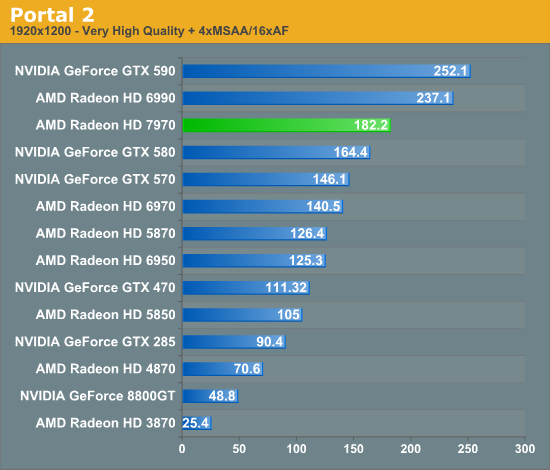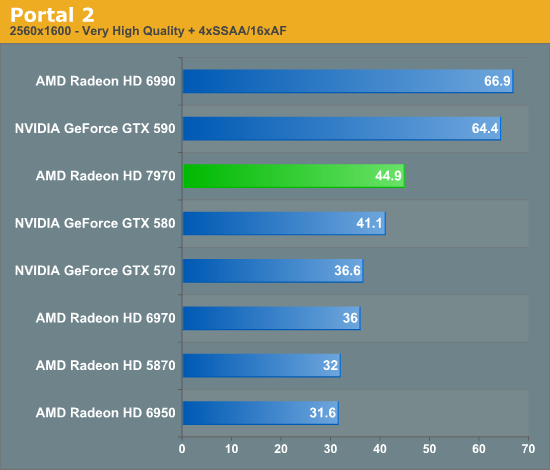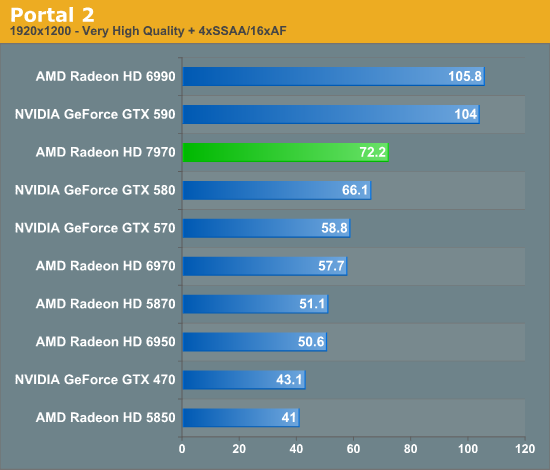AMD Radeon HD 7970 Review: 28nm And Graphics Core Next, Together As One
by Ryan Smith on December 22, 2011 12:00 AM EST- Posted in
- GPUs
- AMD
- Radeon
- ATI
- Radeon HD 7000
Portal 2
Portal 2 continues the long and proud tradition of Valve’s in-house Source engine. While Source continues to be a DX9 engine, Valve has continued to upgrade it over the years to improve its quality, and combined with their choice of style you’d have a hard time telling it’s over 7 years old at this point. Consequently Portal 2’s performance does get rather high on high-end cards, but we have ways of fixing that…


Given Portal 2’s wide range of performance it’s possible to at least somewhat bog it down on the GPU side without any special tricks thanks to its heavier use of shaders than in past Valve titles. Given a fast enough card I believe we could hit the 300fps internal Source framerate cap on our testbed, but thankfully at 2560 we’re nowhere close. In any case at 2560 the 7970 is well into the stratosphere, delivering 128.9fps, which is 18% better than the GTX 580. Meanwhile at 1920 as with so many other benchmarks that lead shrinks, this time down to 11%. Meanwhile the 7970 enjoys a smaller lead over the 6970, beating it by only around 30% at either resolution.


The great thing about the Source engine is that it’s well studied, and by utilizing DirectX9 it’s open to a few more image quality enhancements than DX10+ games. We’ve always wanted to have a standard benchmark with more anti-aliasing than just MSAA, and Portal is the perfect candidate. So for the second part of this test, we’ve turned on Super Sample Anti-Aliasing (SSAA) through NVIDIA and AMD’s driver control panels. With SSAA the entire scene gets anti-aliased, going beyond just removing the jaggies at polygon edges and removing all signs of shader aliasing too, making Portal 2 a very good looking game.
As expected, SSAA makes the performance of everything tank. At 2560 the 7970 is well below 60fps, and every other single-GPU card is slower yet. Once we get down to 1920 performance finally reaches a point where it’s playable, as the 7970 reaches 72.2fps.
Compared to its competition, it’s interesting to note that we appear to have hit an entirely different set of bottlenecks by using SSAA. The 7970 leads the GTX 580 by 9% at both resolutions while it leads the 6970 by 25% under the same conditions. We believe that at this point we’re seeing the limitations of ROP performance, which would explain why the 7970’s lead diminishes versus both the GTX 580 and 6970. The additional bandwidth the 7970’s design affords the ROPs can only go so far until it once again becomes a matter of pixel pushing power.










292 Comments
View All Comments
CeriseCogburn - Thursday, March 8, 2012 - link
Interesting, amd finally copied nvidia..." This problem forms the basis of this benchmark, and the NQueen test proves once more that AMD's Radeon HD 7970 tremendously benefits from leaving behind the VLIW architecture in complex workloads. Both the HD 7970 and the GTX 580 are nearly twice as fast as the older Radeons. "
When we show diversity we should also show that amd radeon has been massively crippled for a long time except when "simpleton" was the key to speed. "Superior architecture" actually means "simple and stupid" - hence "fast" at repeating simpleton nothings, but unable to handle "complex tasks".
LOL - the dumb gpu by amd has finally "evolved".
chizow - Thursday, December 22, 2011 - link
....unfortunately its going to be pitted against Kepler for the long haul.There's a lot to like about Southern Islands but I think its going to end up a very similar situation as Evergreen vs. Fermi, where Evergreen released sooner and took the early lead, but Fermi ultimately won the generation. I expect similar with Tahiti holding the lead for the next 3-6 months until Kepler arrives, but Kepler and its refresh parts winning this 28nm generation once they hit the streets.
Overall the performance and changes AMD made with Tahiti look great compared to Northern Islands, but compared to Fermi parts, its just far less impressive. If you already owned an AMD NI or Evergreen part, there'd be a lot of reason to upgrade, but if you own a Fermi generation Nvidia card there's just far less reason to, especially at the asking price.
I do like how AMD opened up the graphics pipeline with Tahiti though, 384-bit bus, 3GB framebuffer, although I wonder if holding steady with ROPs hurts them compared to Kepler. It would've also been interesting to see how the 3GB GTX 580 compared at 2560 since the 1.5GB model tended to struggle even against 2GB NI parts at that resolution.
ravisurdhar - Thursday, December 22, 2011 - link
My thoughts exactly. Can't wait to see what Kepler can do.Also...4+B transistors? mind=blown. I remember when we were ogling over 1B. Moore's law is crazy.... :D
johnpombrio - Wednesday, December 28, 2011 - link
Exactly. If you look at all the changes that AMD did on the card, I would have expected better results: the power consumption decrease with the Radeon 7970 is mainly due to the die shrink to 28nm. NVidia is planning on a die shrink of their existing Fermi architecture before Kepler is released:http://news.softpedia.com/news/Nvidia-Kepler-Is-On...
Another effect of the die shrink is that clock speed usually increases as there is less heat created at the lower voltage needed with a smaller transistor.
The third change that is not revolutionary is the bump of AMD's 7970's memory bus from 384 bits (matching the 580) from the 6970's 256 bits along with 3GB DDR5 memory vs the GTX580's 1.5GB and the 6970's 2GB.
The final non revolutionary change is bumping the number of stream processors by 33% from 1,536 to 2,048.
Again, breaking out my calculator, the 35% bump in the number of stream processors ALONE causes the increase in the change in the benchmark differences between the 7970 and the 6970.
The higher benchmark, however, does not show ANY OTHER large speed bumps that SHOULD HAVE OCCURED due to the increase in the memory bus size, the higher amount of memory, compute performance, texture fill rate, or finally the NEW ARCHITECTURE.
If I add up all the increases in the technology, I would have expected benchmarks in excess of 50-60% over the previous generation. Perhaps I am naive in how much to expect but, hell, a doubling of transistor count should have produced a lot more than a 35% increase. Add the new architecture, smaller die size, and more memory and I am underwhelmed.
CeriseCogburn - Thursday, March 8, 2012 - link
Well, we can wait for their 50%+ driver increase package+ hotfixes - because after reading that it appears they are missing the boat in drivers by a wide margin.Hopefully a few months after Kepler blows them away, and the amd fans finally allow themselves to complain to the proper authorities and not blame it on Nvida, they will finally come through with a "fix" like they did when the amd (lead site review mastas) fans FINALLY complained about crossfire scaling....
KaarlisK - Thursday, December 22, 2011 - link
What is the power consumption with multiple monitors? Previously, you could not downclock GDDR5, so the resulting consumption was horrible.Ryan Smith - Thursday, December 22, 2011 - link
"On that note, for anyone who is curious about idle clockspeeds and power consumption with multiple monitors, it has not changed relative to the 6970. When using a TMDS-type monitor along with any other monitor, AMD has to raise their idle clockspeeds from 350MHz core and 600Mhz memory to 350MHz core and the full 5.5GHz speed for memory, with the power penalty for that being around 30W. Matched timing monitors used exclusively over DisplayPort will continue to be the only way to be able to use multiple monitors without incurring an idle penalty."KaarlisK - Thursday, December 22, 2011 - link
Thank you for actually replying :)I am so sorry for having missed this.
ltcommanderdata - Thursday, December 22, 2011 - link
Great review.Here's hoping that AMD will implement 64-bit FP support across the whole GCN family and not just the top-end model. Seeing AMD's mobile GPUs don't use the highest-end chip, settling for the 2nd highest and lower, there hasn't been 64-bit FP support in AMD mobile GPUs since the Mobility HD4800 series. I'm interested in this because I can then dabble in some 64-bit GPGPU programming on the go. It also has implications for Apple since their iMacs stick to mobile GPUs, so would otherwise be stuck without 64-bit FP support which presumably could be useful for some of their professional apps.
In regards to hardware accelerated Megatexture, is it directly applicable to id Tech 5's OpenGL 3.2 solution? ie. Will id Tech 5 games see an immediate speed-up with no recoding needed? Or does Partially Resident Texture support require a custom AMD specific OpenGL extension? If it's the later, I can't see it going anywhere unless nVidia agrees to make it a multivendor EXT extension.
Ryan Smith - Thursday, December 22, 2011 - link
Games will need to be specifically coded for PRT; it won't benefit any current games. And you are correct in that it will require and AMD OpenGL extension to use (it won't be accessible from D3D at this time).